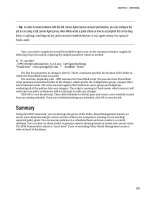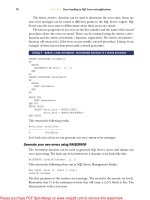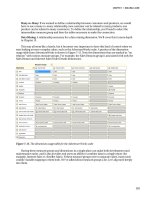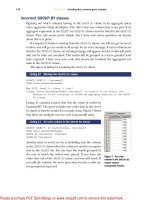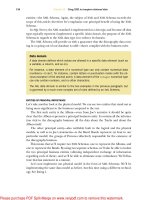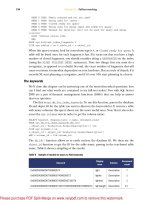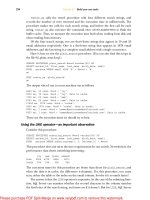SQL Server MVP Deep Dives- P5
Bạn đang xem bản rút gọn của tài liệu. Xem và tải ngay bản đầy đủ của tài liệu tại đây (847.59 KB, 40 trang )
116
CHAPTER 9
Avoiding three common query mistakes
Incorrect GROUP BY clauses
Figuring out which columns belong in the GROUP BY clause in an aggregate query
often aggravates T-SQL developers. The rule is that any column that is not part of an
aggregate expression in the SELECT or ORDER BY clauses must be listed in the GROUP BY
clause. That rule seems pretty simple, but I have seen many questions on forums
about this very point.
If a required column is missing from the GROUP BY clause, you will not get incorrect
results—you will get no results at all except for an error message. If extra columns are
listed in the GROUP BY clause, no warning message will appear, but the results will probably not be what you intended. The results will be grouped at a more granular level
than expected. I have even seen code that incorrectly included the aggregated column in the GROUP BY clause.
The query in listing 10 is missing the GROUP BY clause.
Listing 10
Missing the GROUP BY clause
SELECT COUNT(*), CustomerID
FROM Sales.SalesOrderHeader
Msg 8120, Level 16, State 1, Line 1
Column 'Sales.SalesOrderHeader.CustomerID' is invalid in the select list
because it is not contained in either an aggregate function or the GROUP
BY clause.
Listing 11 contains a query that lists the count of orders by
CustomerID. The query includes the order date in the GROUP
BY clause so that the results do not make sense. Figure 7 shows
that there are multiple rows for each CustomerID value.
Listing 11
An extra column in the GROUP BY clause
SELECT COUNT(*) AS CountOfOrders, CustomerID
FROM Sales.SalesOrderHeader
GROUP BY CustomerID, OrderDate
ORDER BY CustomerID
Another issue to watch out for is including only the column
in the GROUP BY clause when the column is used in an expression in the SELECT list. Say you want the results grouped by
the year in which the orders were placed. If you leave the
order date out of the GROUP BY clause, an error will result. If
you add the column, the error goes away, but the results are
not grouped as expected.
Figure 7 An extra
column in the GROUP BY
clause causes
unexpected results.
Please purchase PDF Split-Merge on www.verypdf.com to remove this watermark.
Licensed to Kerri Ross <>
Summary
Figure 8 Invalid results
because OrderDate
was included instead of
the expression
117
Figure 9 The results
when the expression is
included in the GROUP BY
clause
The query in listing 12 will not produce an error, but the results will not be as
intended. We want a total for each year; therefore, there should only be one row per
year. Figure 8 shows multiple rows for 2001 because the results are grouped by the
order date.
Listing 12
This query runs, but the results are invalid.
SELECT COUNT(*) AS CountOfOrders,
YEAR(OrderDate) AS OrderYear
FROM Sales.SalesOrderHeader
GROUP BY OrderDate
ORDER BY YEAR(OrderDate)
The way to correct the query is to include the exact expression in the GROUP BY clause,
not only the column. Listing 13 shows the corrected query with only four rows
returned this time, one for each year (see figure 9).
Listing 13
Writing the query so that the expression is used in the GROUP BY clause
SELECT COUNT(*) AS CountOfOrders,
YEAR(OrderDate) AS OrderYear
FROM Sales.SalesOrderHeader
GROUP BY YEAR(OrderDate)
ORDER BY YEAR(OrderDate)
Summary
Learning to write T-SQL queries is not a skill you gain overnight. You must overcome
many challenges along the way in order to write queries that return the expected
results. Hopefully, this chapter will help you avoid three common mistakes.
Make sure you always think about NULL, especially when NOT, not equal to, or less
than (<>, !=, or <) is part of the WHERE clause. Remember to continue LEFT OUTER JOIN
down the OUTER JOIN path. And always check your GROUP BY clause to make sure that it
contains the exact non-aggregate expressions and columns from the SELECT list and
ORDER BY clause.
Please purchase PDF Split-Merge on www.verypdf.com to remove this watermark.
Licensed to Kerri Ross <>
118
CHAPTER 9
Avoiding three common query mistakes
About the author
Kathi Kellenberger is a database administrator for Bryan Cave
LLP, an international law firm headquartered in St. Louis, Missouri. She is coauthor of Professional SQL Server 2005 Integration
Services (Wrox, 2006) and author of Beginning T-SQL 2008
(Apress, 2009). Kathi speaks about SQL Server for user groups
and local events and has presented at PASS, DevTeach/SQLTeach, and SSWUG Virtual Conference. She has written over
25 articles, including her first one for SQL Server Magazine in
July 2009. Kathi has been a volunteer for PASS since 2005, winning the PASSion award for her contributions to the organization in 2008.
Please purchase PDF Split-Merge on www.verypdf.com to remove this watermark.
Licensed to Kerri Ross <>
10 Introduction to XQuery
on SQL Server
Michael Coles
Starting with SQL Server 2005, Microsoft added built-in support for XML Query
Language (XQuery). XQuery allows you to query your XML (Extensible Markup
Language) data using a simple, yet powerful, path-style syntax. XQuery support
makes it easy to
Retrieve XML elements from XML content
Extract scalar values from XML data
Check for the existence of elements or values in XML data
Modify your XML data via XML Data Manipulation Language (XML DML)
extensions
SQL Server 2008 includes XQuery support with some slight improvements over the
SQL Server 2005 release. This chapter is designed as an introduction to the XQuery
functionality available in SQL Server. In this chapter we will assume little or no
knowledge of XQuery in general.
What is XQuery?
XQuery is the XML Query Language, as defined by the World Wide Web Consortium (W3C) Recommendation at The XQuery
recommendation provides the syntax and semantics for a language for querying
XML data. XML is a markup language that allows the creation of custom markup
languages. SQL Server provides support for XQuery via the xml data type methods,
listed in table 1.
The primary means of querying XML data using XQuery is with a path-style syntax inherited directly from another W3C recommendation, the XML Path Language (XPath). XQuery and XPath path expressions look similar to an operating
system file path you might enter at a command-line prompt. In fact, if you look at
119
Please purchase PDF Split-Merge on www.verypdf.com to remove this watermark.
Licensed to Kerri Ross <>
120
CHAPTER 10
Table 1
Introduction to XQuery on SQL Server
XML data type methods summary
Description
xml data type method
.exist()
Checks for the existence of a node in your XML data
.modify()
Modifies the content of an XML document
.nodes()
Shreds XML content into relational data
.query()
Queries XML content using XQuery syntax
.value()
Extracts scalar values from XML content
your XML data as similar to an operating system directory structure, you can immediately see the similarities. Consider the simple XML document in listing 1.
Listing 1
Simple XML document
<Math>
<Constants>
<e>2.71828183</e>
<square-root-2>1.41421356</square-root-2>
</Constants>
</Math>
If you were to view this XML document as a filesystem, it might
look something like figure 1.
Like your filesystem, XML is structured hierarchically. If you
wanted to access the contents of the pi file in your filesystem,
you could use a file path like this:
\Math\Constants\pi
Similarly, to access the contents of the
like this:
Figure 1 XML
document viewed as a
filesystem hierarchy
/Math/Constants/pi
XQuery paths come with several options that allow you to create more complex path
expressions to query your XML. For instance, you can use the // axis step to locate any
matching elements below the current element. Using // at the front of your path
expression locates matching elements anywhere they occur in your XML document.
For instance, the following path expression returns <Constants> elements anywhere
they occur in your XML content:
//Constants
Please purchase PDF Split-Merge on www.verypdf.com to remove this watermark.
Licensed to Kerri Ross <>
What is XQuery?
121
You can also use the wildcard character (*) in your path expression to match any
node. The following path expression matches all elements under every <Constants>
element wherever they occur in your XML content:
//Constants/*
The comparison of XML data to a hierarchical filesystem only goes so far. XML data
can be much more complex in structure than a standard hierarchical filesystem. For
example, you can have multiple elements with the same name in an XML document at
the same level. Consider the XML data in listing 2, which has multiple <Colonel> elements at the same level.
Listing 2
XML with multiple instances of the same element at the same level
<Officers>
<Colonel id = "1">Harland Sanders</Colonel>
<Colonel id = "2">Tom Parker</Colonel>
<Colonel id = "3">Henry Knox</Colonel>
</Officers>
In order to query a specific <Colonel> element from the XML document, you need a
method of differentiating them. XQuery provides predicates to fulfill this need. A predicate follows a path expression step and is enclosed in square brackets ([]). The predicate determines which element you want to retrieve. Only elements where the
predicate evaluates to true are returned. As an example, consider a situation in which
you want to return Colonel Tom Parker. Using the XML in listing 2, you could apply a
path expression like the following:
/Officers/Colonel[. = "Tom Parker"]
In this case, the predicate compares the content of the <Colonel> elements to the
string literal "Tom Parker". When it finds one that matches, the matching element is
returned. In this example, it doesn’t make much sense to search for the string literal
"Tom Parker", unless you are just checking to see if the name exists in your
<Colonel> elements.
Using a different predicate, you can retrieve elements by their attributes. Note that
each of the <Colonel> elements in the example has a related id attribute. You can
retrieve Colonel Tom Parker from your XML data by using the id in the attribute, as
shown in the following path expression:
/Officers/Colonel[@id = "2"]
This path expression returns Colonel Tom Parker because his <Colonel> element’s id
attribute is set to 2.
NOTE
In XQuery, you differentiate attribute names from element names by
prefixing attribute names with an at sign (@). In the previous example,
the attribute id is specified as @id in the path expression.
Please purchase PDF Split-Merge on www.verypdf.com to remove this watermark.
Licensed to Kerri Ross <>
122
CHAPTER 10
Introduction to XQuery on SQL Server
XQuery predicates also provide access to a special function known as position(). You
can use the position() function to return an element at a specific position in your
XML data. You can also retrieve Colonel Tom Parker from the sample XML data using
the position() function, as shown in the following path expression:
/Officers/Colonel[position() = 2]
You can also use a special type of predicate, known as a numeric predicate, which consists
of a single integer number, as shown in the following path expression:
/Officers/Colonel[2]
The numeric predicate is functionally equivalent to using the position() function. It
acts similarly to a 1-based array index. The numeric predicate in the example returns
the second instance of a <Colonel> element that it encounters in the path expression—in this case the path expression retrieves the Colonel Tom Parker element.
How XQuery sees your XML
XQuery doesn’t process your XML in its textual form. Querying the text of your XML
documents would have negative results, including the following:
Storing the plain text of your XML documents would be inefficient.
Querying the textual content of your XML documents would degrade perfor-
mance, in many cases severely.
Querying that relies on the raw textual representation of your XML documents
would be inflexible, because you couldn’t assign data types to your XML document content.
In order to accommodate more efficient storage and querying, and to increase flexibility, XQuery converts your raw textual XML data to a format known as the XQuery/
XPath Data Model (XDM). XDM relies on a tree-like representation of your textual XML
document. Consider the XML content in listing 3.
Listing 3
Sample employee XML content
<employee id = "109">
<name>Ken J. Sánchez</name>
<title>CEO</title>
<date-of-hire>2002-10-12</date-of-hire>
</employee>
<employee id = "6">
<name>David Bradley</name>
<title>Marketing Mgr</title>
<date-of-hire>2003-01-04</date-of-hire>
</employee>
NOTE
The full W3C XDM recommendation is available at />TR/xpath-datamodel/.
Please purchase PDF Split-Merge on www.verypdf.com to remove this watermark.
Licensed to Kerri Ross <>
How XQuery sees your XML
123
Document Node
Children:
employee
Type-name: annonymous complex type
Attribute Node
Name:
id
Value:
109
Type-name: integer
Element Node
Name:
name
Parent:
employee
Children:
text
Type-name: ring
Value:
Ken J. Sánchez
Parent:
Content:
Text
name
Ken J. Sánchez
Figure 2
Element Node
Name:
title
Parent:
employee
Children:
text
Type-name: string
Value:
CEO
Parent:
Content:
Text
title
CEO
Element Node
Name:
employee
Parent:
Document Node
Children:
name, title, date-of-hire
Type-name: annonymous complex type
Element Node
Name:
date-of-hire
Parent:
employee
Children:
text
Type-name: date
Value:
2002-10-12
Parent:
Content:
Text
date-of-hire
2002-10-12
Element Node
Name:
employee
Parent:
Document Node
Children:
name, title, date-of-hire
Type-name: annonymous complex type
Element Node
Name:
name
Parent:
employee
Children:
text
Type-name: string
Value:
David Bradley
Parent:
Content:
Text
name
David Bradley
Attribute Node
Name:
id
Value:
6
Type-name: integer
Element Node
Name:
title
Parent:
employee
Children:
text
Type-name: string
Value:
Marketing Mgr
Parent:
Content:
Text
title
Marketing Mgr
Element Node
Name:
date-of-hire
Parent:
employee
Children:
text
Type-name: date
Value:
2003-01-04
Parent:
Content:
Text
date-of-hire
2003-01-04
XDM representation of an XML document
This XML content is logically represented in XDM in a hierarchical form similar to
that shown in figure 2.
XDM provides an efficient hierarchical representation of raw XML textual data.
XDM also allows you to type your XML data, so that you can manipulate XML content
using numeric, date, or other type-specific operations.
NOTE
Creating typed XML instances in SQL Server requires the use of XML
schemas, which are beyond the scope of this chapter.
Also keep in mind that when you store XML data in a SQL Server xml
data type instance, it is automatically converted to XDM form internally.
During the conversion process, SQL Server strips document type definitions (DTDs) and insignificant whitespace from your XML data. It also converts your XML character data content to typed binary representations.
The first thing to notice about the sample XDM representation is that, like your XML
data, it’s hierarchical in structure. XDM converts XML elements and other markup
structures (such as attributes and processing instructions) into logical nodes within
the hierarchical tree structure.
Another interesting feature of XDM is that it can handle both well-formed XML
(having a single root node) and XML content with multiple root nodes. The XML content in listing 3 has two <employee> root elements, meaning the content isn’t wellformed. XDM creates a single conceptual root node at the top of every XDM node hierarchy. This conceptual root node is indicated by the leading forward slash (/) in a path
expression. The conceptual root node allows XQuery to easily query both non–wellformed XML fragments and well-formed XML documents.
NOTE
You can use the keyword DOCUMENT when declaring SQL Server xml data
type columns or variables to restrict their contents to well-formed XML
documents. Alternatively you can use the keyword CONTENT when your
column or variable will contain XML data that has more than one root
Please purchase PDF Split-Merge on www.verypdf.com to remove this watermark.
Licensed to Kerri Ross <>
124
CHAPTER 10
Introduction to XQuery on SQL Server
node, but is otherwise well-formed. I want to stress that although XML
content can have more than one root node, it must follow all other rules
for well-formed XML. In SQL Server terminology, the DOCUMENT and CONTENT keywords indicate facets that constrain your xml data. The default
facet is CONTENT. More information is available in Books Online at http://
msdn.microsoft.com/en-us/library/ms187339.aspx.
Querying XML
As we discussed in the section “What is
XQuery?” SQL Server’s xml data type exposes
several methods that allow you to query and
manipulate XML data using XQuery. The
.query() method is the most basic xml data type
method. It accepts an XQuery expression and
returns an XML result. Consider listing 4, which
creates an xml data type variable, assigns an XML
document to it, and then queries the document
using the xml data type .query() method. The
result is shown in figure 3.
Listing 4
Figure 3 Retrieving XML via the
.query() method
Querying XML data
DECLARE @x xml;
SET @x = N'<?xml version = "1.0"?>
<definitions category = "Business Intelligence">
<concept>
<name>star schema</name>
<definition>
The star schema (sometimes referenced as star join schema) is the
simplest style of data warehouse schema. The star schema consists of
a few "fact tables" (possibly only one, justifying the
name) referencing any number of "dimension tables". The
star schema is considered an important special case of the snowflake
schema.
</definition>
<source>Wikipedia</source>
</concept>
<concept>
<name>snowflake schema</name>
<definition>
A snowflake schema is a logical arrangement of tables in a relational
database such that the entity relationship diagram resembles a
snowflake in shape. Closely related to the star schema, the snowflake
schema is represented by centralized fact tables which are connected
to multiple dimensions. In the snowflake schema, however, dimensions
are normalized into multiple related tables whereas the star
schema's dimensions are denormalized with each dimension being
represented by a single table.
</definition>
Please purchase PDF Split-Merge on www.verypdf.com to remove this watermark.
Licensed to Kerri Ross <>
Querying XML
125
<source>Wikipedia</source>
</concept>
</definitions>';
SELECT @x.query(N'/definitions/concept[2]/name');
As you can see, the XQuery path expression follows the hierarchical structure of the
XML document. The first step of the path expression starts at the root of the XML document and then looks below to the <definitions> element. The second step uses a
numeric predicate [2], indicating that the second occurrence of the <concept> element should be selected.
Finally, the last step of the path expression indicates that
the <name> element under the <concept> element should
be retrieved.
The .value() method accepts both a path expression
and a SQL Server data type. It returns a single scalar value
from the XML data, cast to the appropriate data type. The
SELECT query in listing 5 uses the .value() method on Figure 4 Single scalar
the xml data type variable defined in listing 4. The result value returned by the
.value() method
is shown in figure 4.
Listing 5
Retrieving a single scalar value
SELECT @x.value(N'(/definitions/concept[2]/name)[1]', N'nvarchar(100)');
The entire path expression is wrapped in parentheses in this example, and a numeric
predicate of [1] is used on the entire path expression. This ensures that only a single
scalar value is returned. The .value() method will not accept any path expression
that isn’t guaranteed, during the pre-execution static analysis phase of processing, to
return a single scalar value.
NOTE
XQuery uses two-phase processing. Initially there’s a static analysis phase,
during which XQuery checks syntax, data typing, and conformance to
any special requirements (such as returning only a single node or single
scalar value when necessary). XQuery performs pessimistic static type
checking, meaning that it’ll throw errors during the static analysis phase
whenever the path expression could potentially generate a static type
error. After the static analysis phase, XQuery goes into the execution phase,
where your path expression is evaluated against your data.
The xml data type also provides the .exist() method, which accepts a path expression and returns 1 if the query returns any nodes, and alternatively returns 0 if the
query doesn’t return any nodes. Consider listing 6, which tells you whether the word
dimensions appears in the character data of any of the <definition> elements in the
XML data. This sample relies on the sample data used in listing 4. Results are shown in
figure 5.
Please purchase PDF Split-Merge on www.verypdf.com to remove this watermark.
Licensed to Kerri Ross <>
126
CHAPTER 10
Listing 6
Introduction to XQuery on SQL Server
Confirming existence of a node
SELECT CASE @x.exist
(
N'/definitions/concept/definition[contains(., "dimensions")]'
)
WHEN 1 THEN N'The word "dimensions" exists in a definition'
WHEN 0 THEN N'The word "dimensions" doesn''t exist in a definition'
END;
Figure 5 Results of using the .exist()
method to check for node existence
TIP
Listing 6 introduces a new XQuery function, contains(), which works
similarly to (but not exactly like) the SQL Server CHARINDEX() function to
determine whether a given string is contained within your data. The full
list of XQuery functions and operators (often referred to with the abbreviation F &O) available to SQL Server XQuery is available in Books Online
at />
In this example, we used a different predicate that uses the XQuery contains function. This function accepts a node and a string value. In this example, we used the
period character (.), which indicates the current context node. The predicate returns
true for every node that matches the predicate criteria. In this case, every node that
contains the word dimensions returns true. The contains function (like XML in general, and by extension XQuery) is case sensitive. The .exist() method is most commonly used in the WHERE clause of SQL statements.
The .nodes() method allows you to shred your XML data or convert it into relational form. This method accepts a path expression and returns a relational result set
of matching nodes as an xml data type column. The .nodes() method requires you to
alias the result set and column name that will be returned. In listing 7, we used the
alias Result for the returned result set and Col for the single xml data type column in
that set. Again, this sample relies on the XML data introduced in listing 4. Partial
results are shown in figure 6.
Listing 7
Shredding XML with the .nodes() method
SELECT Col.value(N'(./name)[1]', N'nvarchar(100)') AS [Name],
Col.value(N'(./definition)[1]', N'nvarchar(1000)') AS [Definition]
FROM @x.nodes(N'//concept') Result(Col);
Please purchase PDF Split-Merge on www.verypdf.com to remove this watermark.
Licensed to Kerri Ross <>
FLWOR expressions
Figure 6
127
Shredding XML data with the .nodes() method
Querying .nodes() results
Although the .nodes() method returns a result set of xml data type, it is a functionally limited version of the xml data type. You can’t query the result set instances directly. The only way to access the contents of the result set are through the use of
the other xml data type methods, such as .value() or .query(). If you do try to
query the contents directly, you’ll get an extremely verbose error message similar to
the following:
Msg 493, Level 16, State 1, Line 35
The column 'Col' that was returned from the nodes() method cannot be
used directly. It can only be used with one of the four XML data type
methods, exist(), nodes(), query(), and value(), or in IS NULL and IS
NOT NULL checks.
FLWOR expressions
You can take advantage of powerful XQuery FLWOR expressions (an acronym for the
XQuery keywords for-let-where-order by-return) in SQL Server. FLWOR expressions
let you act on tuple streams as they’re generated by your path expression.
NOTE
In terms of XQuery, a tuple stream is a stream of nodes returned by a path
expression. FLWOR expressions act on a tuple stream that’s generated by
the for clause. The return clause returns the result of the tuple stream.
The FLWOR expression, at a minimum, requires a for clause and a return clause, as
shown in listing 8. As in previous examples, listing 8 relies on the XML data introduced in listing 4. Results are shown in figure 7.
Listing 8
Querying XML with a FLWOR expression
SELECT @x.query
(
N'for $i in //name
return <topic>{$i/text()[1]}</topic>'
);
Please purchase PDF Split-Merge on www.verypdf.com to remove this watermark.
Licensed to Kerri Ross <>
128
CHAPTER 10
Introduction to XQuery on SQL Server
Figure 7 Result of a simple
FLWOR expression
In this example, the for clause generates a tuple stream from the //name path expression and binds each tuple to the $i variable in turn. The tuple stream consists of the
stream of tuples returned by each iteration of the for clause. The return clause
returns the concatenated results generated by the tuple stream.
This simple FLWOR expression demonstrates an interesting feature of XQuery:
XML construction. XML construction allows you to generate new XML content from
source XML content. In this case, we’ve taken the content of every <name> element in
the source XML document and reformatted that content as <topic> elements.
The let keyword allows you to bind tuples generated by the for clause tuple
stream to variables. Consider listing 9, where we use the let clause to assign the character content of each <name> element to a variable named $j. The results are the same
as those generated by listing 8.
Listing 9
Binding tuples to variables with the let clause
SELECT @x.query
(
N'for $i in //name
let $j := $i/text()[1]
return <topic>{$j}</topic>'
);
NOTE
The let clause wasn’t implemented in SQL Server 2005 XQuery, but is
available in SQL Server 2008.
The order by clause allows you to sort your results. The FLWOR expression in listing 10
sorts the results in ascending order by the character content of the <name> elements.
The results, shown in figure 8, are the reverse of those shown in figure 7.
Listing 10
Sorting tuples with the order by clause
SELECT @x.query
(
N'for $i in //name
let $j := $i/text()[1]
order by $j ascending
return <topic>{$j}</topic>'
);
Figure 8 Results of a FLWOR
expression with the order by
clause
Please purchase PDF Split-Merge on www.verypdf.com to remove this watermark.
Licensed to Kerri Ross <>
XQuery comparison operators
129
The order by clause can accept the ascending or descending keywords to indicate
sort direction. Ascending is the default if you don’t explicitly specify a sort order. If
you don’t use an order by clause in your FLWOR expressions, results are always
returned in document order. Document order is the default order in which elements
occur in your XML document or data. The FLWOR expression order by clause is functionally similar to the T-SQL ORDER BY clause.
Finally, the FLWOR expression where clause allows you to limit the results returned
with a predicate. The FLWOR expression’s where clause is analogous to the T-SQL
WHERE clause. Listing 11 modifies the previous example slightly. This version adds a
where clause that limits the results to only those where the content of the <source>
element is equal to the string "Wikipedia".
Listing 11
Restricting results with the where clause
SELECT @x.query
(
N'for $i in //concept
let $j := ($i/name/text())[1], $k := ($i/source/text())[1]
where $k eq "Wikipedia"
order by $j ascending
return <topic>{$j}</topic>'
);
The predicate in the where clause uses the same operators as predicates in path
expressions. These operators are described in the next section.
XQuery comparison operators
XQuery supports several operators for comparing values, nodes, and sequences. A
sequence is an ordered collection of zero or more items. The items can be nodes or
atomic values, although SQL Server supports only homogenous sequences, or those
that don’t mix nodes and atomic values in a single XQuery sequence.
NOTE
The term ordered, as it applies to XQuery sequences, generally means document order as opposed to alphabetic or numeric order. In the XPath 1.0
recommendation, the concept of node sets is used instead of sequences. In
node sets, the order is unimportant and duplicate nodes are disallowed.
XQuery sequences stress the importance of order (as order is important
in XML documents), and allow duplicate nodes.
Sequences are represented as follows in XQuery:
(10, 1, (2, 3), 5, 4, 6, 7, 8, 8, (), 9)
Sequences are a core concept within XQuery, and worth discussing further. Some of
the important things to notice about the preceding sequence:
Sequences in XQuery can be represented as comma-separated lists of values
wrapped in parentheses.
XQuery understands the concept of the empty sequence, represented by empty
parentheses: ().
Please purchase PDF Split-Merge on www.verypdf.com to remove this watermark.
Licensed to Kerri Ross <>
130
CHAPTER 10
Introduction to XQuery on SQL Server
XQuery sequences can contain subsequences, such as the (2, 3) sequence,
which is a component of the larger sequence in the example.
Sequences can contain numeric values, character strings, and values of other
data types.
A sequence like the one shown is “flattened out” so that subsequences become part of
the larger sequence, and empty sequences are removed. After this initial processing,
the preceding sequence looks like the following to the XQuery processor:
(10, 1, 2, 3, 5, 4, 6, 7, 8, 8, 9)
An interesting and useful property of sequences is that any sequence containing only
a single atomic scalar value is equivalent to that atomic scalar value. Because of this
property, the sequence (3.141592) is equal to the atomic scalar value 3.141592, and
the code sample in listing 12 returns a result of true.
Listing 12
Comparing a sequence with a single value to a scalar value
DECLARE @x xml;
SET @x = N'';
SELECT @x.query('(3.141592) eq 3.141592');
XQuery supports several operators that can be used in expressions and predicates.
These operators are listed in table 2.
Table 2
XQuery comparison operators
Value comparison operators
General comparison operators
eq
Equal to
ne
Not equal to
!=
Not equal to
gt
Greater than
>
Greater than
ge
Greater than or equal to
lt
Less than
le
Less than or equal to
=
>=
<
<=
Equal to
Greater than or equal to
Less than
Less than or equal to
Node comparison operators
is
Node identity equality
>>
Left node follows right node
<<
Left node precedes right node
XQuery comparison operators are classified in three groups, as shown in table 2. Value
comparison operators are those operators that allow you to compare scalar atomic values
to one another. Listing 13 demonstrates the lt value comparison operator. The result
returned is true.
Please purchase PDF Split-Merge on www.verypdf.com to remove this watermark.
Licensed to Kerri Ross <>
XQuery comparison operators
Listing 13
131
Comparing with the value comparison operators
DECLARE @x xml;
SET @x = N'';
SELECT @x.query('"ABC" lt "XYZ"');
The second group of operators, general comparison operators, contains those operators
classified as existential operators. Existential operators compare all atomic values contained in sequences on both sides of the operator, and if any of the comparisons
return true, the result of the entire comparison is true. Consider the two general
comparisons in listing 14.
Listing 14
Comparing sequences with general comparison operators
DECLARE @x xml;
SET @x = N'';
SELECT @x.query('(1, 2, 3) > (3, 4, 5)');
SELECT @x.query('(1, 2, 3) = (3, 4, 5)');
The first comparison uses the general comparison > (greater-than) operator. Because
none of the scalar atomic values in the sequence on the left are greater than any of
the scalar atomic values in the sequence on the right, the result of the entire comparison is false. The second comparison uses the = general comparison operator.
Because the “3” in the sequence on the left is equal to the “3” in the sequence on the
right, the result of the comparison is true.
The final group of operators consists of the node comparison operators. These operators allow you to compare nodes. In listing 15, the first expression uses the node comparison << operator to determine whether the /family/mother node appears before
the /family/father node, in document order. The second expression uses the is
operator to determine whether the first node returned by the //child path is the
same as the first node returned by the /family/child path expression. The result of
both expressions in the example is true.
Listing 15
Comparing nodes with the node comparison operators
DECLARE @x xml;
SET @x = N'<?xml version = "1.0"?>
<family surname = "Adams">
<mother>Morticia</mother>
<father>Gomez</father>
<child>Pugsley</child>
<child>Wednesday</child>
<uncle>Fester</uncle>
</family>';
SELECT @x.query('(/family/mother)[1] << (/family/father)[1]');
SELECT @x.query('(//child)[1] is (/family/child)[1]');
The is operator checks whether two nodes are actually the same node. Two nodes
that might otherwise be considered equivalent (same node name, same character data
Please purchase PDF Split-Merge on www.verypdf.com to remove this watermark.
Licensed to Kerri Ross <>
132
CHAPTER 10
Introduction to XQuery on SQL Server
content, and so on), but aren’t the exact same node, aren’t considered the same by
the is operator.
XML indexes and XQuery performance
Whenever you query XML data on SQL Server, it is automatically converted to relational format behind the scenes. In this way, SQL Server can leverage the power of the
relational query engine to fulfill XQuery queries. But on-the-fly shredding is an
expensive process that can slow down overall processing. One answer to this problem
is to use XML indexes. You can create a primary XML index on an xml data type column on a table to “pre-shred” your XML data. By pre-shredding the XML data, you
avoid the overhead involved with on-the-fly shredding.
You can also create secondary XML indexes on your xml data type columns. These
secondary XML indexes are relational indexes created on top of the primary XML
index. You can choose from three types of secondary XML indexes, each designed to
optimize access for different types of XQuery expressions. The creation and administration of XML indexes is beyond the scope of this chapter, but bear in mind that
they’re available to help increase XQuery performance efficiency. The downside to
XML indexes is that they can substantially increase the storage requirements for xml
data type columns.
NOTE
More information on XML indexes is available at http://msdn.
microsoft.com/en-us/library/ms191497.aspx.
Summary
This concludes our introduction to the basics of XQuery. XQuery is a powerful XML
querying language, with far more features than we can cover in this introductory
chapter. With built-in support for XQuery path expressions, standard XQuery comparison operators, FLWOR expressions, XML DML, and a wide variety of additional
functions and operators, SQL Server provides a powerful XQuery implementation
that can be used to query and manipulate XML on SQL Server.
About the author
Michael Coles is a SQL Server MVP and consultant based in
New York City. Michael has written several articles and books
on a wide variety of SQL Server topics, including Pro SQL Server
2008 XML and the Pro T-SQL 2008 Programmer’s Guide. He can
be reached at .
Please purchase PDF Split-Merge on www.verypdf.com to remove this watermark.
Licensed to Kerri Ross <>
11 SQL Server XML frequently
asked questions
Michael Coles
With the SQL Server 2005 release, Microsoft implemented new and exciting XML
integration into SQL Server. These features include the following:
A new native xml data type
XML content indexing
Improvements to the FOR XML clause
Improvements to the OPENROWSET function
Integrated support for XML Schema
Native XQuery (XML Query Language) support
Access to additional XML-specific functionality via SQL CLR integration
All of this functionality, with some additional improvements, is included in SQL
Server 2008. Many developers have questions about how to take advantage of this
new functionality. This chapter is structured in a frequently-asked-questions (FAQ)
format, and will answer many of the most common questions raised by developers
who want to use SQL Server–based XML functionality in their applications. We will
start with the basics.
XML basics
XML introduces a lot of terminology and concepts that can be new and confusing
to SQL developers, or developers coming from other languages. In this section we
will discuss some of these basic concepts.
What’s XML?
XML is an acronym for Extensible Markup Language. XML is a specification for creating custom markup languages. A markup language is an artificial language that consists of textual annotations, or markup tags, that control the structure or display of
textual data. XML allows you to create your own custom markup language,
133
Please purchase PDF Split-Merge on www.verypdf.com to remove this watermark.
Licensed to Kerri Ross <>
134
CHAPTER 11
SQL Server XML frequently asked questions
meaning you define the markup tags that give structure and additional context to
your textual data. Listing 1 shows a simple XML document.
Listing 1
Sample XML document
<?xml version = "1.0"?>
<!-- This is a simple XML document -->
<country name = "United States of America">
<states>
<state>
<abbreviation>NJ</abbreviation>
<name>New Jersey</name>
</state>
<state>
<abbreviation>NY</abbreviation>
<name>New York</name>
</state>
</states>
</country>
This XML document consists of a root-level markup tag named country. Nested within
this tag, in a hierarchical structure, is a states markup tag with additional state tags
nested within it, and so on. XML is handy for representing hierarchical textual data,
and is useful for manipulating and sharing text-based data over the internet.
The XML specification divides the different types of supported markup annotations into logical structures known as nodes. Nodes are a useful logical construct for
working with XML content. A node can be one of the following types, as shown in the
sample XML document:
Element nodes—Element nodes consist of markup tags that wrap other nodes
and textual data. The element <abbreviation>NJ</abbreviation> in the
example is an element named abbreviation that contains the text data NJ.
Attribute nodes—Attribute nodes are name/value pairs associated with element
nodes. In the example, the country element has an associated attribute named
name, which is assigned the value "United States of America".
Text nodes—Text nodes are the bottom-level nodes that contain character data
within element nodes. The second name element contains a text node containing the character data New York.
Comment nodes—Comment nodes are human-readable comments that can
appear anywhere in XML documents outside of other markup. The delimiters are used to indicate a comment node, as in the example where
the comment <!-- This is a simple XML document --> appears.
Processing instructions—Processing instructions provide a means to pass additional information to the application parsing the XML data. Processing instructions are indicated by delimiting them with <? and ?>. In the example, a special
processing instruction known as the prolog is used to indicate the version of the
XML recommendation that this document conforms to. The prolog in this
example is <?xml version = "1.0"?>.
Please purchase PDF Split-Merge on www.verypdf.com to remove this watermark.
Licensed to Kerri Ross <>
XML basics
135
Processing Instruction
Content:
xml version="1.0"
Comment
Attribute
Element
Content: This is a simple XML document
Name:
country
Name:
states
Name: name
Value: United States of America
Element
Element
Element
Name:
Name:
state
abbreviation
Value:
NJ
Name:
name
Value:
New Jersey
Text
Figure 1
Element
Element
Element
Name:
state
Name:
abbreviation
Value:
NY
Element
Name:
name
Value:
New York
Text
Text
Text
XML tree structure
XML data can be logically viewed as a set of nodes in a hierarchical tree structure. Figure 1 shows the sample XML document when viewed as a tree.
The XML node tree structure works well in support of other XML-based processing
and manipulation recommendations that logically view XML data as hierarchical treelike structures. These recommendations include XML Infoset, XML Schema, XML
DOM, and XQuery/XPath Data Model, to name a few. Each of these recommenda-
tions can define extra node types in addition to these basic node types, such as document nodes and namespace nodes.
What’s “well-formed” XML?
XML data must conform to certain syntactical requirements. XML that follows the syn-
tactical requirements below is considered well-formed:
1
2
3
Well-formed XML data must contain one or more elements.
Well-formed XML data must contain one, and only one, root element. In the sample XML document presented in the previous section, the country element is
the root element. It contains all other elements within its start and end tags.
Well-formed XML data must have all elements properly nested within one
another. This means no overlapping start and end tags. The start and end tags
of the states element don’t overlap the other tags, such as the nested state,
abbreviation, and name tags.
In addition to these requirements, XML character data must be properly entitized,
which we will talk about in the next section. XML data that conforms to all of these
rules is considered well-formed.
Please purchase PDF Split-Merge on www.verypdf.com to remove this watermark.
Licensed to Kerri Ross <>
